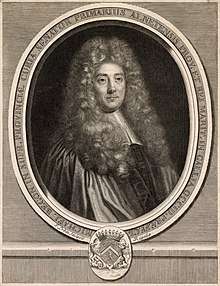Michel Bégon de la Picardière
Michel Bégon de la Picardière (21 March 1667 – 18 January 1747)[1] was an early administrator in charge of the French colony of New France, in what is now the province of Quebec, Canada.
Michel Bégon de la Picardière | |
|---|---|
 | |
| Born | 21 March 1667 |
| Died | 18 January 1747 |
Early life
Bégons was born into a French family with a history of service to the King of France in fiscal and judicial matters. His father, Michel V Bégon, was intendant of the port of Rochefort from 1688 to 1710.[2][3]
Career
Bégon was appointed to serve as the intendant of New France in 1710.[4] However, he, his new wife Jeanne-Élisabeth de Beauharnois de La Boische, and his brother Claude-Michel sailed for the colony in 1712.[5] He replaced the co-intendants, Antoine-Denis Raudot and Jacques Raudot and held the position from 1712–1726.[6] During his tenure he conducted a laissez-faire approach to governing the settlement's entrepreneurs.[7] There are indications that he carried out questionable dealings in wheat and other agricultural products during his early years, using his position and the card money system to enrich himself.[8] Many of his letters and reports to the government of France have been preserved; they show him to have been an avid naturalist, and included plans and suggestions for making the colony more self-sufficient. One of these suggestions was the introduction of slavery.[9]
The last three years of his service as intendant were unexpected, as one successor died at sea before the new intendent, Claude-Thomas Dupuy, arrived. Upon the arrival of his replacement, Bégon left almost immediately for France where he continued his career.
See also
References
- R. M. Dipanda. Black Race, Who Are You?: Great Black Race Chronoholocaust Cataclysm. Xlibris US; 28 January 2018. ISBN 978-1-5434-7734-4. p. 458–.
- The Memoir of Lieutenant Dumont, 1715–1747: A Sojourner in the French Atlantic. UNC Press Books; 19 November 2013. ISBN 978-1-4696-0865-5. p. 74–.
- Iroquoisie: 1688-1701. Les éditions du Septentrion; 1998. ISBN 978-2-89448-124-0. p. 43–.
- Marcel Moussette.'"Québec 1713. Le palais de l'intendant brûle", Erudit, No. 63, 2009. p.73.
- Marcel Moussette. Le site du Palais de l'intendant à Québec: genèse et structuration d'un lieu urbain. Les éditions du Septentrion; 1994. ISBN 978-2-89448-014-4. p. 218–.
- Mélinda Wilson. Fleurs comestibles: du jardin à la table. Les Editions Fides; 2007. ISBN 978-2-7621-2782-9. p. 48–.
- "La représentation en Nouvelle-France". Bulletin d'histoire politique. by Christian Blais
- Beauregard, France (4 March 2015). "Michel Bégon de La Picardière". The Canadian Encyclopedia. Historica Canada.
- Zoltvany, Yves F. (1974). "Bégon de la Picardière, Michel". In Halpenny, Francess G (ed.). Dictionary of Canadian Biography. III (1741–1770) (online ed.). University of Toronto Press.